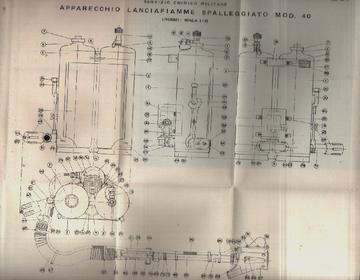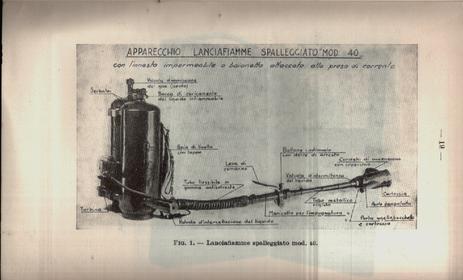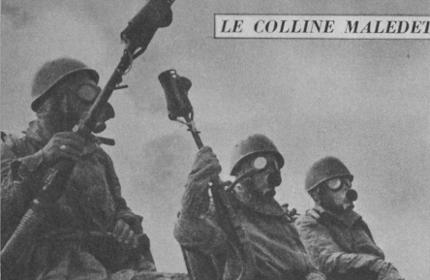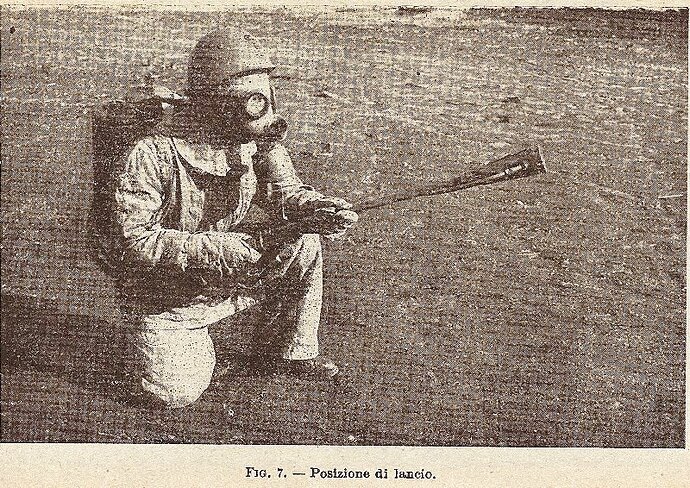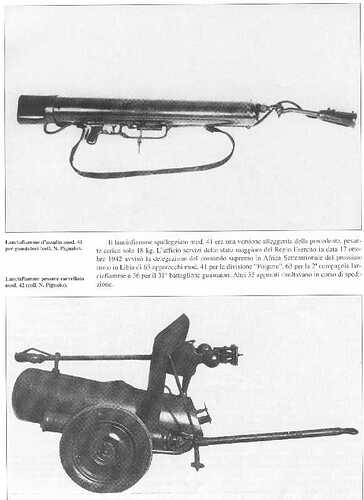Italian army used in WW2 5 main kinds of flamethrowers. The mod. 35, the mod. 40, the mod. 41, the mod. 41 d’assalto (a special version of mod. 41 for paratroopers, guastatori and other assault troops, a really modern and effective weapon in service among the Italian special units until 1990s) and the mod. 42 carrellato.
The two most used were the Mod.35 and the Mod.40, both shoulder mounted flamethrowers. Many were exported in Finland and in Romania.
At the beginning of the 2nd World War The Italian Army had normally for every Army Corps (Corpo d’Armata) one “L” Company (L=Lanciafiamme) formed by two platoons each formed by two squads. Each squads had 8 flamethrowers, for a total of 32 per Army Corps.
Therefore according to Italian 1940 Order of Battle, every infantry division had at least one squad with 8 flamethrowers.
The units more trained in the use of flamethrowers were the Guastatori. The “Scuola Guastatori” (“Assault Engineers specialization school”) was in Civitavecchia (Rome). The purpose of Guastatori was to support infantry troops using the flamethrowers and explosive charges like “Bangalore tubes” or other explosive devise, and to clean dangerous areas from mines or explosive traps.
Lanciafiamme Spalleggiabile (=portable) Model 35.
Weight 27 Kg, it had a storage of 12 lts of flammable fluid for 20" of continual flow jet or 10 brief jets, at a distance of 20 mts.
The main deficiency of the weapon was the ignition system: a small torch “Bengala” Type (called the “bengalotto”) at the extremity of the barrel had to be ignited before the beginning of the combat, it burned slowly but could be easily spotted by the enemy.
Lanciafiamme Spalleggiabile model 1940.
Weight 25,5 Kg, it had a storage of 18 lts of flammable fluid, its performances were very similar to the one above with an improved electric ignition system: the high-pressure fluid jet pushed the blades of a small rotor as a turbine, the magnetized rotor worked as a dynamo and the electric energy was carried by wires to a sparking plug at the extremity of the barrel.
The Mod.40 ignition system was improved respect the Mod.35 and started with an electric turbine.
Lanciafiamme Spalleggiabile model 1941.
Weight 24,5 Kg, it was an emprovement of the mod. 40. Built with a lighter aluminium alloy it had a third tank of flammable fluid, for about a 30% more load than the mod. 40, with a lower weight.
Lanciafiamme d’Assalto Mod 41.
This was a very good assault weapon issued to special units only, it was still in service until 1990s in the Italian Army.
Its handling was comparable to a rifle because the body of the weapon WAS the tank of the flammable fluid.
The barrel was articulated and could be oriented up to 90 grades, so the soldier could shoot behind a protection or well orient the jet inside enemy bunkers or pillboxes.
It had a dynamo-turbine ignition system.
It had a weight of 9 kgs with its fluid storage, and it had a range of 23 mts with a burst of 4" of continual flow jet, or more with intermittent brief jets.
Lanciafiamme Pesante Carrellato Model 42.
This one was rarely employed by infantry troops.
It had a range of about 70 mts and 100 lts of flammable fluid storage propelled by nitrogen or by a motorized pump. This heavy storage was contained in a “bombola” (tank) on wheels linked to the ejector by a long retractile and flexible tube.
It was considered a complex and heavy weapon not useful for assault and fast employements, but it could be very effective against fixed positions.
